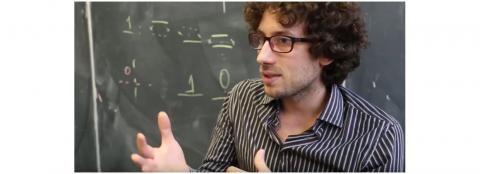
Hugo Duminil-Copin, a mathematician at the interface
Newly arrived at IHES, probabilist Hugo Duminil-Copin looks set to add to an already impressive number of collaborations, publications and awards.
"There are so many ways of doing mathematics!" Dr. Duminil-Copin says enthusiastically. Dr. Dumenil-Copin, himself a probabilist who works at the interface between mathematics and physics, joined IHES, a member of Université Paris-Saclay, as a full professor in September 2016.
A normal man
Claiming to be "not especially gifted" in mental arithmetic, Dr. Duminil-Copin says his education followed a typical course. Guided by the school system, he ended up choosing math over physics "without really knowing what a mathematician was." So he's pleased now to find himself surrounded by "normal" people. Harry Kesten in particular, a "living god" for Duminil-Copin the student, turned out to be a "very natural, very humble gentleman."
A team effort
Following an agrégation in mathematics at École normale supérieure de Paris and a master's degree at Université Paris-Sud, he did his PhD at the University of Geneva and went on to teach there.
Dr. Duminil-Copin was recruited to IHES with the help of an IDEX Chair from Université Paris-Saclay. This means he'll be able to set up a team within the Institute, taking advantage of the Université Paris-Saclay environment—an exciting prospect because for him, mathematics happens more through discussion than on paper.
Moreover, he works mainly with a big blackboard as a source of and aid for discussion.
From the microscopic to the macroscopic
In his research, Dr. Duminil-Copin has developed his taste for physics, dialoguing with many scientific fields. From the statistical study of the microscopic systems, he deduces the properties of macroscopic objects or phenomena: porous materials, the behavior of gases, the propagation of a fire or an epidemic, magnetization, etc. In particular, he studies the Ising model, which makes it possible to represent magnets, for example, in three dimensions, as a collection of small magnets that can only be in one of two states (facing the south or north magnetic poles).
The mathematician is also interested in "universality", this time in two dimensions. A model always relies on rules and parameters chosen by the modeler to represent a phenomenon. The understanding of this phenomenon must depend as little as possible on the rules chosen; that is, a small modification of these rules must not lead to a different interpretation of the phenomenon. So Dr. Duminil-Copin seeks to verify the universality of his models.
Several prestigious awards
2016 was also a successful year for the professor. He was awarded the European Mathematical Society (EMS) Prize at the 7th European Congress of Mathematics in July. He was also one of four winners of the New Horizons in Mathematics Prize from the Breakthrough Foundation in December. Founded five years ago by Yuri and Julia Milner and some of Silicon Valley's great entrepreneurs (Sergey Brin, Anne Wojcicki, Mark Zuckerberg and Priscilla Chan), the Breakthrough Prizes acknowledge outstanding scientists in the fields of mathematics, physics and life sciences.
Reason to aspire to the Fields Medal, perhaps? Presented as the mathematics equivalent of the Nobel Prize, the Fields Medal has often been awarded to mathematicians who had previously won the EMS Award.
